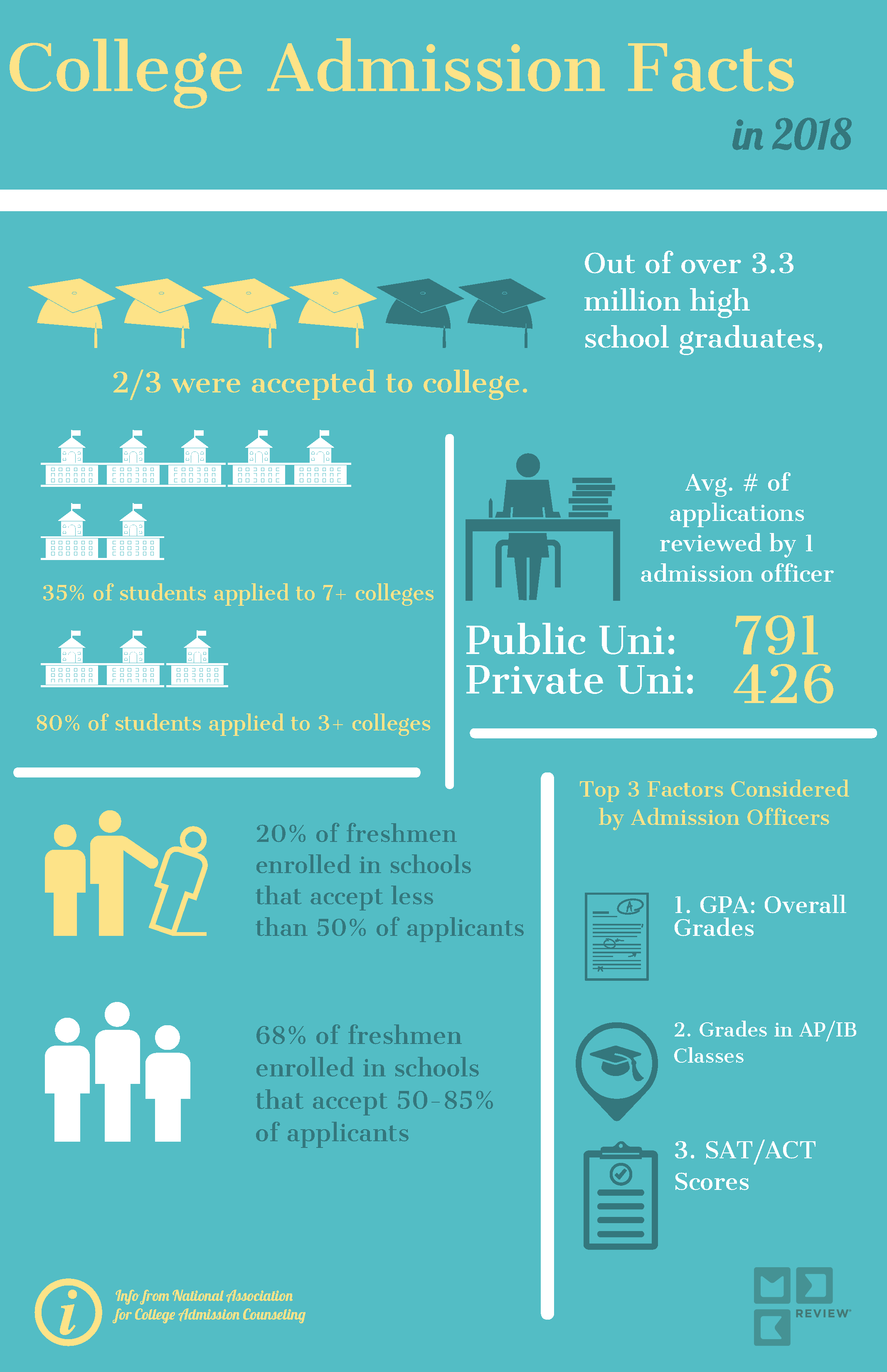
College Admissions Trends You Need to Know
College Admissions Facts You Should Know
Check out this set of top facts about college admissions, put together by our team at MEK Review:

A Closer Look
What do these stats mean for you as a student or parent? Let’s look at these numbers more closely:
Fact #1: 2/3 of H.S. Seniors Enroll in College.
This works out to over 2 million incoming freshman at two-year and four-year colleges.
According to the National Association for College Counseling, the percentage of enrolling college freshman has increased by 4% over 2016 and 2017. This does not include transfer students and international students, the enrollment rate of which has also increased by 3% and 8% respectively.
Together, that is a significant increase in enrollment! If you’re stressed out, wondering if you’ll ever make it into college, take a look at the millions of students who have successfully achieved admissions over the past few years alone.
That said, for many colleges, the number of students accepted into freshman class is not changing, despite the increasing number of applications. What this means is that competition continues to escalate, especially for the most selective of schools.
Fact #2: There Are A High Number of Applications.
7 applications is a lot of applications!
As you can see from our infographic, 35% of college applicants are applying to that many schools or more! Additionally, almost all applicants are applying to at least 3 schools. With the online convenience of the Common Application and the Coalition Application, it is easier than ever for students to apply to multiple colleges in an effort to increase their chances.
However, keep these tips in mind:
-
- Begin early: Completing 3-7 applications takes time! You need to start early.
- Quality first: Remember, it’s better to complete 5 well-thought out, prepared college applications, than 10 rush jobs.
- Aim for range: When you’re deciding where to apply, don’t just pick the 8 Ivy Leagues or 5 top schools you can think of. Your prospective college list should be a thoughtful list with a mixture of Reach, Target, and Safety schools. Safety schools are schools where your chances of admission are very high and almost guaranteed. Target schools are colleges where your grades, test scores, and other key factors make you an ideal candidate. Reach schools are the more selective universities where competition is fierce but you are ready to take it on!
Explore how MEK Review’s team of counselors can guide you through every step of the way through our Roadmap to College program.
Fact #3: Number of Applications Far Outweigh the Number of Admissions Officers.
The lesson you can take from this figure is simple.
One admissions officer is reviewing hundreds upon hundreds of applications! With so much to review, admission officers are likely searching for reasons to eliminate, not accept! Why? By finding reasons to eliminate an application, they can more quickly narrow the candidate pool down.
So you have to make sure your application checks all the right boxes: grades, test scores, amazing essay, great recommendations, so you don’t fall into the rejection pile. Check out our blog “Why Your College Essay is So Important” to see how your essay is the one thing that can set you apart from thousands of other applicants.
Fact #4: The Selectivity of Colleges Matters. A Lot.
Most people know that Harvard and Princeton are difficult to get into.
After all, they have an acceptance rate of less than 5% (last year, in fact, Princeton’s dropped below 5%). However, even a school that on average accepts less than 50% of applications, only accounts for 20% of the total number of 2018 college freshmen. Most students attend universities with a much higher rate of acceptance (50-85%).
What does this mean for you?
Research a school’s average acceptance rate to help create your list of Target, Reach, and Safety schools. One great resource is US News.
Fact #5: Pay Attention to the Top 3 Factors for College Acceptance.
This may come as no surprise: colleges judge you based on grades and test scores.
However, it is interesting to note that in the past, grades in College Prep courses such as AP and IB classes were more highly weighted by admission officers than overall GPA. However, with the influx of students in these type of courses, overall, grades is now the #1 factor.
Another point to note is that the more selective the school, the more all of your competition will likely have impressive grades and test scores. With application numbers on the rise, you will need to focus on other important factors looked at by colleges such as application essays, recommendations, SAT Subject test scores, and extracurricular activities.
How to Put It All Together
With so many students applying to so many colleges, the college admissions process can seem daunting. How exactly do you pick your Reach, Target, and Safety schools? How do you make your application stand out? And how do you know exactly what colleges are looking for?
It can seem overwhelming, but all you really need is a plan.
First, check out our blog: College Admissions: What’s Your Pie Chart? to get a better sense of where you stand right now as an applicant. You need to know your own strengths and weaknesses in the eyes of an admission officer, so you can figure out how to stand out more in your application. Plus, understanding your areas of strength can help you choose a college that is right for you, one that will appreciate and nurture what you’re best at.
Next, receive a consultation from our experienced College Admissions Counselors so you can prepare an application which stands out in the crowd and gets you to your dream school!



